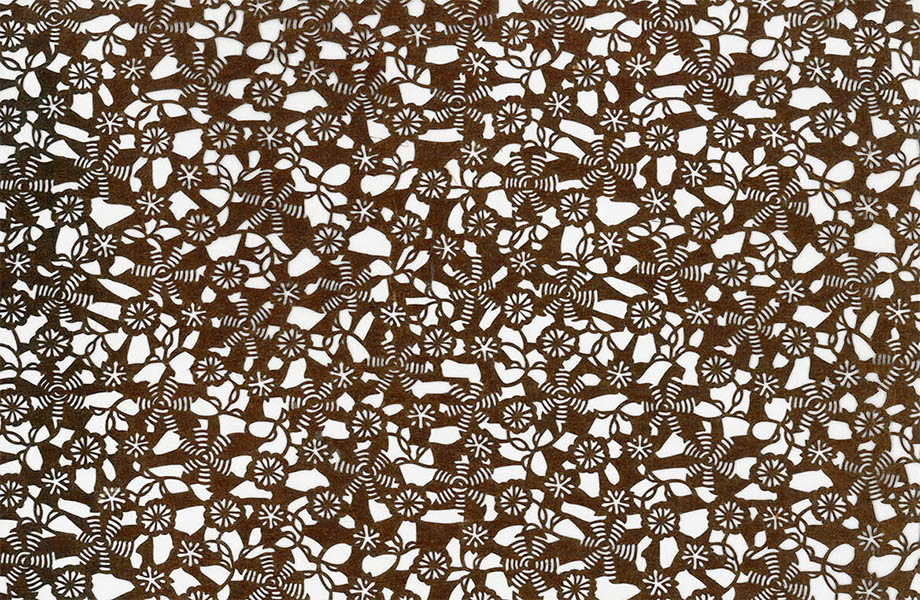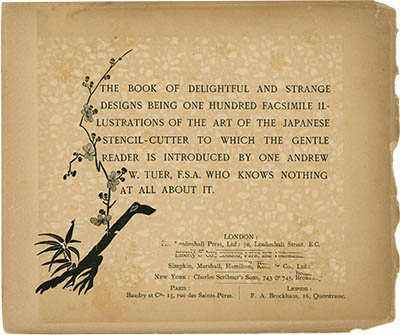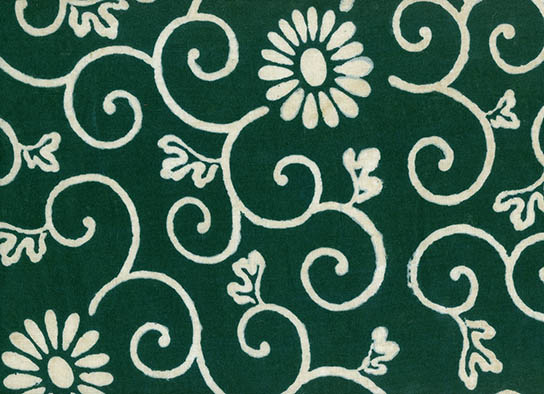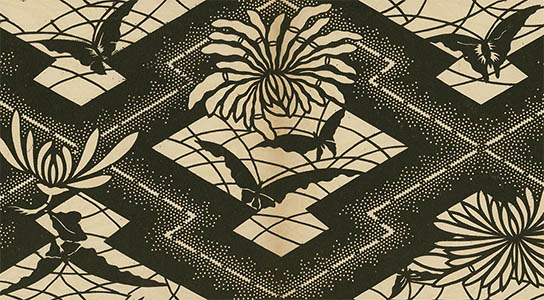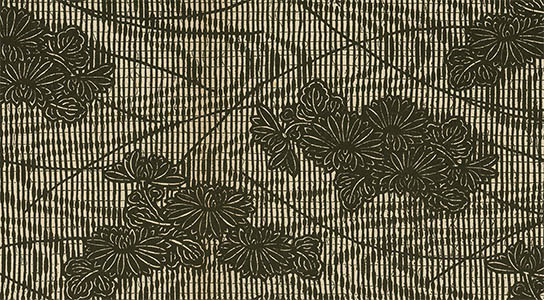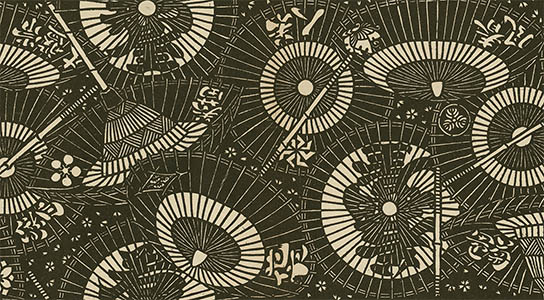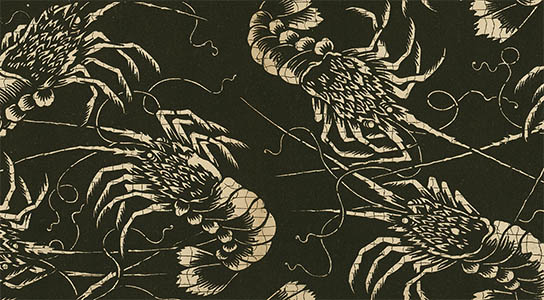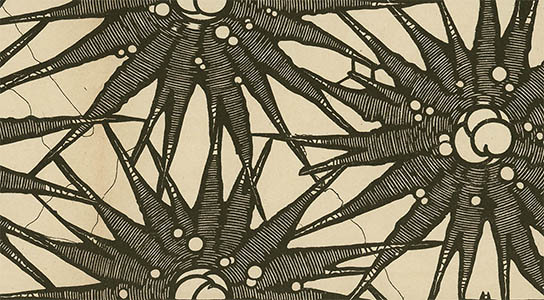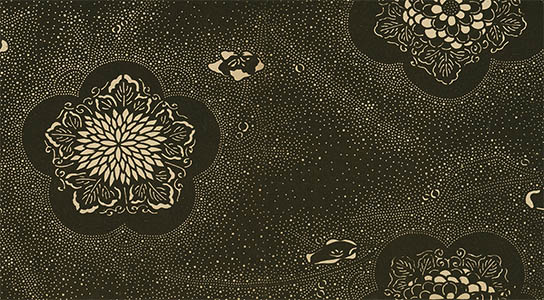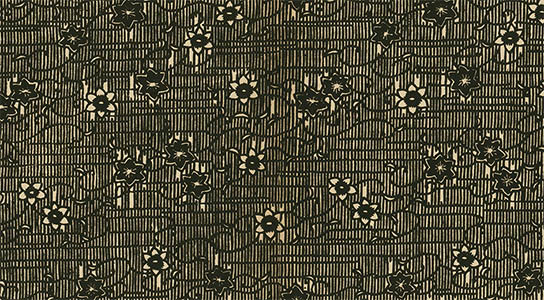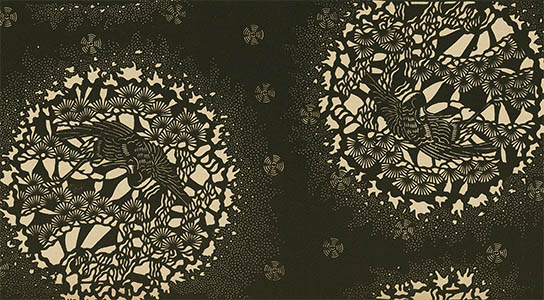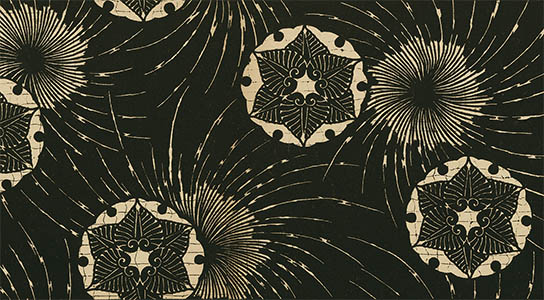Here is a detail from the beautifully intricate, hand-cut stencil that was bound in as the frontispiece in Andrew Tuer’s classic The Book of Delightful and Strange Designs Being One Hundred Facsimile Illustrations of the Art of the Japanese Stencil-Cutter – and that is just the short title:
Japanese textile weaving and dying goes back to the eight century AD, however finely brocaded silk, e.g., would be within the reach of only nobility or royalty, so by the 17th century artisans around Suzuka developed katazome (型染め) – a simpler, less costly fabric-dying technique to mimic the appearance of finely-woven textiles.
Simple is, of course, relative. The katazome technique goes something like this: a stencil (katagami) was prepared from several layers of handmade mulberry paper (kozogami) laminated together with persimmon juice then smoked in a sawdust fire. The result was a flexible, but surprisingly durable panel into which designs were cut with a combination of knives, punches and awls. The designs became so intricate that eventually a silk mesh was used to support the minute details.
The katagami was placed over the fabric, typically hemp or cotton, and a rice bran paste resist (norizome) was brushed on. The fabric was sized with soybean milk (tonyu) and dyed, typically with indigo. The rice paste was then washed off, leaving the design.2
Here are details from a few mid-century katazome-dyed examples in the Codex 99 Study Collection:3
In Japan the stencils were seen as entirely utilitarian objects but in 19th century Japonisme-crazed Europe they were seen as art in and of themselves. This is where Andrew Tuer comes in.
Andrew White Tuer (25 Dec 1838 – 24 Feb 1900) began as a stationer in London where, among other things, he invented Stickphast Paste and the popular Author’s Paper Pad (the first writing pad with detachable sheets). Tuer, with his partner Abraham Field, moved to 50 Leadenhall Street in 1868 and began the appropriately named Leadenhall Press.
Tuer was an “omnivorous collector” who filled his Notting Hill house with “books, engravings, clocks, china, silver and bric-a-brac of the most varied description” and the Leadenhall catalog, which was variously described as “eclectic and whimsical” or “quirky and charming,” tended to mirror his wide-ranging interests in typography, engraving, children’s literature and antiquarian subjects. Some highlights from the nearly 450 known items printed by the press include Luxurious Bathing (1879), Bartolozzi and His Works (1882), 1000 Quaint Cuts from Books of Other Days (1886), The History of the Horn-Book (1896) and Pages and Pictures from Forgotten Children’s Books (1898).
Although now largely forgotten, Field and Tuer’s press was one of the most innovative publishers in late Victorian England.4
No. 1, chrysanthemums and butterflies
No. 2, hare and waves
No. 5, chrysanthemums on moire antique ground
No. 8, umbrellas with characters and crests of owners
The Art of the Japanese Stencil-Cutter grew out of Tuer’s interest in a collection of stencils and related materials acquired by the South Kensington Museum (now the V&A) and was the first ever treatise on the subject.
The book consisted of an essay in English, German and French as well as 40 fold-out facsimiles and 64 smaller details that showed the range of classical Japanese design motifs. As Tuer wrote:
“Many – perhaps most – of the stencils are pregnant with meaning, and illustrate or suggest legends and superstitions either borrowed from the Chinese or having their origin in the dim mists of Japanese antiquity.”
Of course he was right – every design has a specific meaning. Although many of them are centuries old they manage to look remarkably modern.
No. 12, crayfish
No. 16, splashed design
No. 20, Chrysanthemums on ground suggested by gold spotted lacquer ware
No. 30, conventionalized flowers
No. 31, cranes with highly conventionalized pines
No. 34, conventional floral design with rays of light
1. Tuer, Andrew. The Book of Delightful and Strange Designs, Being One Hundred Facsimile Illustrations of the Art of the Japanese Stencil-cutter to which the Gentle Reader is Introduced by one Andrew W. Tuer, F.S.A. Who Knows Nothing at All About It. London: Leadenhall Press, Ltd., 1892 (online). The book was republished as Japanese Stencil Designs: One Hundred Outstanding Examples Collected and Introduced by Andrew W. Tuer. New York: Dover, 1967. The scans here are from an original 1892 edition kindly loaned to me by my friend Mary.
2. For more about the technique see: Evans Dee, Elaine. Kata-game; Japanese Stencils in the Collection of the Cooper-Hewitt Museum. Washington, D.C., The Smithsonian Institution, 1979 (online).
3. The Codex 99 Study Collection consists of textiles stuffed into the drawers of an old Sheraton dresser in your humble narrators’ living room World Headquarters. The Japanese stuff is mostly in the top drawer.
4. For more about Tuer and his press see: Young, Matthew McLennan. Field & Tuer, The Leadenhall Press: A Checklist. New Castle, Delaware: Oak Knoll Press, 2010 (WorldCat).
20 Feb 2013 ‧ Design
